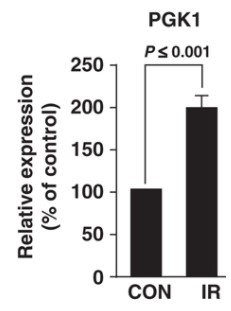PGK1
-
Official Full Name
phosphoglycerate kinase 1 -
Overview
The protein encoded by this gene is a glycolytic enzyme that catalyzes the conversion of 1,3-diphosphoglycerate to 3-phosphoglycerate. The encoded protein may also act as a cofactor for polymerase alpha. This gene lies on the X-chromosome, while a related pseudogene also has been found on the X-chromosome and another on chromosome 19. -
Synonyms
PGK1;phosphoglycerate kinase 1;PRP 2;primer recognition protein 2;cell migration-inducing gene 10 protein;PGKA;MIG10;MGC8947;MGC117307;MGC142128
Recombinant Proteins
- Human
- Zebrafish
- Mouse
- Rhesus macaque
- Rat
- Chicken
- Cynomolgus
- Chinese hamster
- E.coli
- Sf21 Insect Cell
- Mammalian Cell
- Insect Cells
- HEK293
- Human
- Insect Cell
- Yeast
- Human Cells
- Mammalian cells
- HEK293T
- E. coli
- His
- Non
- Myc&DDK
- His&Fc&Avi
- Flag
- GST
Background
What is pgk1 protein?
PGK1 protein, also known as phosphoglycerate kinase 1, is an enzyme that plays a crucial role in glycolysis. It catalyzes the conversion of 1,3-bisphosphoglycerate to 3-phosphoglycerate, generating ATP in the process. PGK1 is found in all tissues and is involved in the production of energy in the form of ATP during cellular metabolism. It is also used as a marker in clinical diagnostics for certain diseases and used as a model protein in biochemical and biophysical studies.
What is the function of pgk1 protein?
Metabolism: It plays a critical role in glycolysis by facilitating the conversion of 1,3-biphosphoglycerate to 3-phosphoglycerate. This helps generate ATP from glucose breakdown.
Energy production: By generating ATP, PGK1 contributes to cellular energy production which is essential for basic metabolic processes and growth.
Glycolysis: It is a major enzyme involved in glycolysis, the process by which glucose is oxidized to pyruvate to produce energy in the presence of oxygen.
Pgk1 related signaling pathway
Glycolysis pathway: PGK1 catalyzes a central reaction (step 7) in glycolysis that generates ATP by converting glucose to pyruvate. This fuels the glycolytic pathway.
PI3K/Akt/mTOR pathway: PGK1 activity supports growth signaling through PI3K/Akt/mTOR by providing ATP and metabolic intermediates for anabolic processes.
HIF-1 pathway: Hypoxia-induced PGK1 upregulation helps stabilize HIF-1α and activate HIF-1 target genes to promote aerobic glycolysis in cancer.
PKA pathway: cAMP/PKA signaling influences PGK1 expression and glycolytic activity in response to various stimuli like hormone levels.
PGK1 Related Diseases
Cancer: PGK1 is frequently upregulated in cancers to meet their increased metabolic demands. Its inhibition may combat tumor growth.
Hemolytic anemia: Defects in PGK1 can cause chronic hemolytic anemia due to impaired ATP generation in erythrocytes.
Neurological disorders: Mutations in PGK1 have been linked to such conditions as generalized dystonia and cerebellar ataxia.
Diabetes: Altered PGK1 expression and activity may contribute to pathogenesis of diabetes through disrupted glucose metabolism.
Coronary artery disease: Higher PGK1 levels are observed in coronary artery disease patients, indicating roles in cardiovascular disease.
Skeletal muscle disorders: Mutations impairing PGK1 glycolytic function cause myopathy characterized by muscle weakness.
Biomedical Application of PGK1 Protein
- Disease biomarker: PGK1 expression levels could indicate tumor progression, diabetes risk, etc.
- Drug target: Inhibiting PGK1 may slow cancer growth by blocking glycolysis fueling tumor cells.
- Gene therapy: Correcting defective PGK1 genes may help treat related genetic disorders.
- Tissue engineering:Studying PGK1's role in differentiated cell metabolism aids disease modeling.
Case Study

(Young-Bin Lim, 2011)
Fig2. Expressions of PGK1 and TA1 in intestines and brains, respectively. Mice were exposed to 1 Gy of whole body IR for 24 h, and the expressions of PGK1 and TA1 in indicated tissues were measured by Western blotting. (A) The expressions of PGK1 in the indicated tissues of three mice exposed to whole body IR (1 Gy, 24 h) were determined by Western blotting (left panel). Densitometric analysis of changes in the expressions of PGK1 in indicated tissues.

(Zhong Chu, 2021)
Fig3. Left panel shows the expression levels of PGK1 and LINC00926 in MCF-7 cells transfected with scrambled or LINC00926 siRNA. Right panel shows expression levels of PGK1 and LINC00926 in MDA-MB-231 cells transfected with empty vector and LINC00926 expression vector. The data are presented as the mean ± SD.
Quality Guarantee
High Purity

Fig1. SDS-PAGE (Cat. No.: PGK1-1506C)
Involved Pathway
PGK1 involved in several pathways and played different roles in them. We selected most pathways PGK1 participated on our site, such as Glycolysis / Gluconeogenesis,Metabolic pathways,Carbon metabolism, which may be useful for your reference. Also, other proteins which involved in the same pathway with PGK1 were listed below. Creative BioMart supplied nearly all the proteins listed, you can search them on our site.
| Pathway Name | Pathway Related Protein |
|---|---|
| Metabolic pathways | HIBADH,G6PCA.1,ALDH1B1,ALDH3A2A,GMPS,CYP4F18,GCNT4A,LIPCA,CYP19A1B,LASS4 |
| Biosynthesis of amino acids | ASL,PFKP,GLULB,PSAT1,MAT2AL,PKM,PFKMB,CS,MAT2AA,TAT |
| Glycolysis / Gluconeogenesis | ALDH2.1,GPI1,PGM2,DLDH,G6PCA.1,G6PC2,ADH6,ALDH9A1A.1,FBP1,ADH2-2 |
| HIF- signaling pathway | GAPDH,Il6ra,EP300,PRKCB,ENO3,NPPA,IFNGR2,HMOX1,MKNK1,EIF4E2 |
| Carbon metabolism | PRPS1,MTHFR,IDH3G,FBP2,PGAM1,SDHD,OGDH,HADHA,AMT,ACSS1 |
Protein Function
PGK1 has several biochemical functions, for example, ATP binding,phosphoglycerate kinase activity,protein binding. Some of the functions are cooperated with other proteins, some of the functions could acted by PGK1 itself. We selected most functions PGK1 had, and list some proteins which have the same functions with PGK1. You can find most of the proteins on our site.
| Function | Related Protein |
|---|---|
| protein binding | TUFM,CSNK1E,INO80,NFYA,UBA1,CIDEB,MED4,PSTPIP1,WIPI2,FBXO45 |
| phosphoglycerate kinase activity | PGK2 |
| ATP binding | ADRBK1,KIF2C,UBE2D1B,ACTG2,MAPKAPK5,CKMT2B,ATP12A,CASKA,SGK3,GTF2F2 |
Interacting Protein
PGK1 has direct interactions with proteins and molecules. Those interactions were detected by several methods such as yeast two hybrid, co-IP, pull-down and so on. We selected proteins and molecules interacted with PGK1 here. Most of them are supplied by our site. Hope this information will be useful for your research of PGK1.
GAPDH;PIK3C2A;FOXO3;GBAS;Cdk1;PCNA;PRKAG1;YWHAZ;Bles03;NRBF2;ATG101;DDA1;UBA5;Csnk1e;SH3GLB2;PRKAG2;p29991-pro_0000037945;tnpA;pstS
Resources
Related Services
Related Products
References
- Lim, YB; Pyun, BJ; et al. Proteomic identification of radiation response markers in mouse intestine and brain. PROTEOMICS 11:1254-1263(2011).
- Ardizzoni, A; Posteraro, B; et al. AN ANTIBODY REACTIVITY-BASED ASSAY FOR DIAGNOSIS OF INVASIVE CANDIDIASIS USING PROTEIN ARRAY. INTERNATIONAL JOURNAL OF IMMUNOPATHOLOGY AND PHARMACOLOGY 27:403-412(2014).


